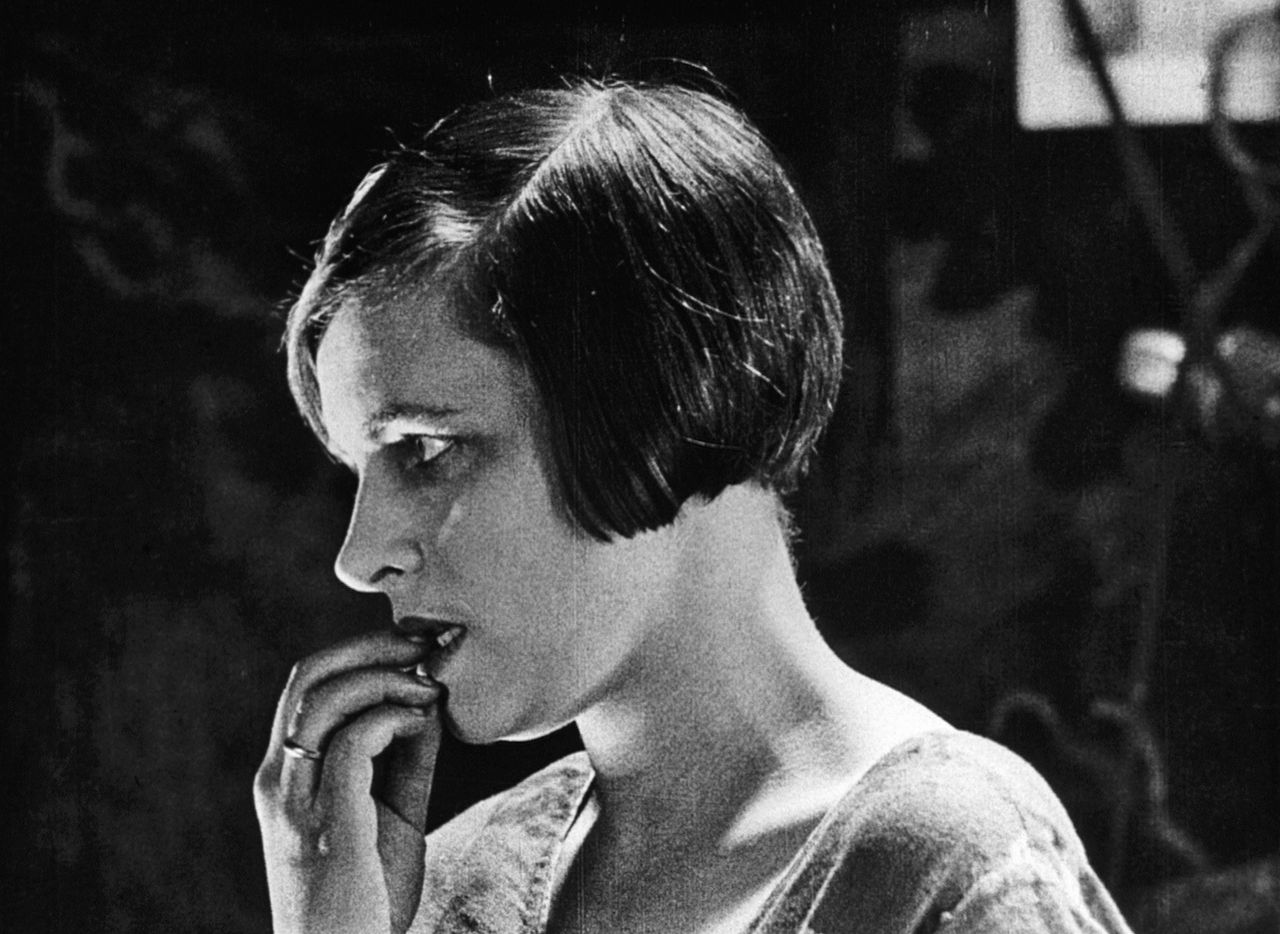In his seminal work, Men Without Women: Masculinity and Revolution in Russian Fiction, 1917-1929, Eliot Borenstein characterized the period of Russian history immediately following the October Revolution as an era of immense sexual upheaval, arguing that the Soviet Union experienced not one, but two sexual revolutions occurring “at opposite ends of the sociopolitical spectrum … simultaneously” (5). The course of these twin revolutions, one radically progressive and the other reactionary, can be traced through contemporary Soviet film.
The Early Soviet Push to Abolish the Family
With the rise of the Bolshevik regime, young communists saw an opportunity to reformulate sexual and familial relationships in a way that would provide the foundation for the new proletarian society. In their crusade against bourgeois social mores, intellectuals targeted the most basic unit of social organization within the capitalist labor economy: the family.
In Men Without Women, Borenstein attributes this attitude not only to “decades of ideological debates” (3) that had condemned the family as an irredeemably bourgeois archaism, but also to the complete and utter devastation wrought by the twin horrors of the Great War and the Russian Civil War. With “millions of orphans, widows, and divided spouses” (Borenstein 3) already spread across the societal landscape of postbellum Russia, many of the more radical Soviet intellectuals demanded an end to the familial unit altogether, arguing that the state could fulfill the needs of the individual and the collective more effectively than any kinship-based organizational system.
Even as authorities retreated from the rigid structures of war communism and began allowing limited forms of private enterprise as part of the New Economic Policy (NEP), social reform continued to progress along strictly revolutionary lines as dictated by the ruling Bolshevik intelligentsia. In 1918, the Central Executive Committee of the Soviet (VTsIK) ratified the first family code of the Soviet Union: the Code on Marriage, the Family, and Guardianship. Drafted by the prominent Bolshevik jurist and intellectual Alexander Goikhbarg, the code “abolished the inferior legal status of women and created equality under the law” (51 Goldman). Divorce became freely available to both parties for the first time in Russian history, and civil marriage replaced religious marriage as the only romantic union recognized by the state. Special protections for women in the workforce were even instituted, including a ban on nightwork.
However, these laws were only ever meant to be stopgap measures until the family could be dissolved entirely. Many prominent intellectuals, Goikhbarg among them, believed that the family institution would wither away as soon as women could be extricated from the burden of housework and child rearing. Alexandra Kollontai, who went on to serve in high-ranking positions in the Bolshevik government, espoused similar rhetoric, arguing that “[s]ewing, cleaning, and washing, like mining, metallurgy, and machine production, would become branches of the people’s economy” (Goldman 5). In her 1923 magazine article “Make Way for Winged Eros,” she argues that “each class strives to fill the conception of love with a moral content that suits its own interest” (Kollontai 169) and that only by replacing the exclusivity of bourgeois marriage with collective “love-comradeship” (Kollontai 171) can a truly united proletarian society succeed. The goal of Soviet social policy in the very earliest years of the USSR – as exemplified by the philosophies of these revolutionaries – was no less than the complete arrogation of the domestic into the public sphere.
Anti-Family Rhetoric in Bed and Sofa and Alone
This official hostility towards the family as an institution seeped into the cinematic fabric of early Soviet art. Filmmaker Abram Room’s 1927 film, Bed and Sofa, for instance, framed the prevailing argument against marriage and the family as the logical conclusion of broader negotiations over Russia’s cultural heritage. The renovation of the Bolshoi Theater in the background of the film, a symbol of the cultural renewal of Russia, ties the narrative into the greater struggle against bourgeois backwardness (Bed and Sofa 9:45-10:50).
The film was considered immensely controversial even at the time of its release. The tripartite love affair between the film’s three protagonists parallels that of the relationship at the heart of Nikolai Chernyshevsky’s 1863 novel What Is to Be Done? In the novel, the heroine, Vera Pavlovna, and her revolutionary compatriots arrive at an agreement similar to Kollontai’s love-comradeship in which the individual partners are allowed to form and dissolve sexual relationships at will. Chernyshevsky treats this new ideal of free union as a liberating and welcome alternative to marriage. In the film, however, the three protagonists – Liuda, Kolia, and Kolia’s friend Volodia – only arrive at such an arrangement grudgingly, and it proves to be an insurmountable point of contention for the two male partners. Tellingly, when the two are asked what relation they have to Liuda late in the film, they both reply that they are still her “husbands” (Bed and Sofa 1:20:10). Room clearly still views even this liberated association as much too close to the bourgeois form of marriage decried by contemporary revolutionaries. Meanwhile, the watchful eyes of the state – appearing unobtrusively in the form of Stalin’s portrait hanging on the wall – observe the ongoing experiment attentively as a kind of silent mediator (7:00).
Marriage, for Liuda, is something stifling: it forcibly redirects her productive impulses towards pointless domestic labor and reduces her to the status of a commodity or luxury good. Room illustrates this through a dream sequence in which Kolia explicitly equates Liuda with his rocking chair and other lost articles of furniture (Bed and Sofa 49:09). Marriage according to the film is an explicitly capitalist association built on the economic exploitation of labor. Liuda cannot be a good Soviet citizen and a good wife at the same time. Indeed, as a wife to Kolia and Volodia, she spends her days miserably staring out the windows of her apartment on Meshchanskaya Street – a Russian word that roughly translates as “petty bourgeoisie” (55:00). Liuda can only actualise herself as a worker after she liberates herself from this antiquated, bourgeois structure. The final sequence of a pregnant Liuda running away from the city and her marriage aboard a steaming locomotive symbolizes the triumphant liberation of Soviet women from bourgeois domination (1:25:50).
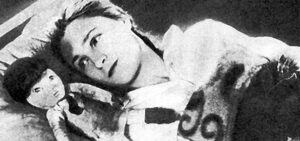
Leonid Trauberg’s Alone, released in 1931, was one of the last major films of the period to explicitly depict the family as an impediment to social betterment. Trauberg displays the same revolutionary distaste for the traditional institution of marriage as seen in Bed and Sofa, using virtually identical techniques: Yelena equates marriage with the ownership of material goods through a series of daydreams while shopping with her fiancé, illustrating the capitalist mindset that underlies the traditional family structure (Alone 8:05).
The rejuvenation and gradual transformation of Yelena from counterrevolutionary to dedicated Soviet citizen can only be accomplished once she has willingly liberated herself, through labor in the Far East, from the bourgeois temptation posed by her fiancé. The architect of this removal is none other than the omnipotent voice of the state – and, by extension, Stalin himself – directing the construction of the new Soviet society through cryptic proclamations over the public announcements system (Alone 12:25).
Yet even in this seemingly anti-family screed, there is already an inkling of Borenstein’s “second sexual revolution” (7). Stalin must necessarily exist as an unembodied agent despite his progressively active presence in society, for to condense him into the form of a man would be to limit his potentiality. Stalin’s invasive and all-knowing voice mediates Yelena’s liberation directly through announcements and indirectly through the unseen official that handles her paperwork. Not limited by physical presence, Stalin is able to insert himself into the lives of all citizens.
Although Yelena ostensibly rejects her fiancé and the possibility of family, she does so in order to prove herself worthy of what is essentially an exclusive marriage to the Soviet state. Despite not being sexually procreative, this union still provides Yelena with surrogate children in the form of her Siberian schoolchildren in the Far East, proving that a family centered on the state can be compatible with socialist ideals (Alone 59:03).
The Stalinist Reactionary Counterrevolution
However, these overwhelmingly negative portrayals of the family as a bourgeois institution all but vanished by the time of the Great Break in 1928 and the solidification of Stalinism in the 1930s.. Free access to divorce had resulted in scores of proletarian women being abandoned by their husbands. Unable to earn a living wage due to discrimination in the labor market, many were forced to resort to prostitution as a means of supporting themselves and their families. Conservative Bolshevik officials and jurists, concerned with protecting women’s interests, argued that “Soviet family policy encouraged sexual behavior that the economies of family and state could not accommodate” (Goldman 239). Many women demanded that the law guaranteeing equal access to divorce be repealed. Members of the Women’s Department of the Secretariat of the Central Committee (Zhenotdel) even called for a ban on nighwork to be repealed “so that employers would have less excuse to lay off women workers” (Goldman 117). The Chernyshevskian ideal of free union, although technically possible under the new law, was practically impossible under contemporary economic conditions. Radical writers and philosophers held on to the promise of future revolution, but “destruction of the family became a distant goal that would be pushed further and further into the radiant future” (Borenstein 12). Any lingering hope for the abolishment of the traditional family – and traditional marriage by extension – withered as the state distanced itself from radical sexual liberation.
Furthermore, in 1936, socialist realism became the official artistic style of the Soviet Union. While previously artists had possessed the relative freedom to express dissenting political views, socialist realism forced them to work within a narrow ideological framework, one which could change overnight depending on the whims of state censors. Control of artistic output through socialist realism meant that all literature and film produced during this period had to conform completely to Soviet policy. That policy was to politicize the family by “transforming the family from domestic refuge to instrument of social control” (Borenstein 13). Under the new reactionary program set forth by the Stalinist regime, “[f]amily laws were again tightened, and motherhood and responsibility became official ideals” (Borenstein 7). The structure of the institution was altered to insure increased civic obedience: Soviet policy maintained and even strengthened the traditional patriarchal dynamic, but removed the husband from his position as head of the family and replaced him with the state – embodied in art by the hypermasculine figure of Stalin.
The Counterrevolution Shown in Tractor Drivers, Tanya, and Fall of Berlin
The omnipresent intercession of the state – as exemplified by both the physical and metaphorical personage of Stalin – played an increasingly important and visible role in the entrenchment of marriage in Soviet film in the 1930s. Later films of this period illustrate the transition from Stalin as an ethereal force in the lives of the Soviet populace to a physical entity exerting both literal and symbolic influence over the sexual relationships between citizens. Liberated female protagonists continued to be held up as examples of social progress in Soviet art, but the value of these women to the broader public depended in no small part on their relationships with men – and, by extension, with Stalin. This reordering of values can be seen particularly in the portrayals of women in contemporary Soviet film.
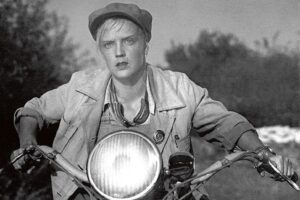
In Ivan Pyryev’s Tractor Drivers (1939), Maryana lives the sort of idealized proletarian lifestyle that Liuda (from Bed and Sofa) sought as an alternative to the shackled domesticity of the apartment. However, she appears to be someone just as much in need of taming as the wild fields that she and the other tractor drivers strive to cultivate. The mechanism for taming Maryana comes in the form of her marriage to the handsome Klim. This is the type of exclusive relationship that the revolutionaries Kollontai and Isaev derided as antithetical to the ideals of the new proletarian regime. The final scene of Tractor Drivers depicts the wedding feast as an instance of social bonding, uniting the entire community at the banquet table (Tractor Drivers 1:20:35). Furthermore, the strategic placement of Stalin’s portrait – hung directly above the bridegroom – emphasizes the fact that the ultimate source of authority within the relationship lies with Stalin and the omnipotent state that he represents.
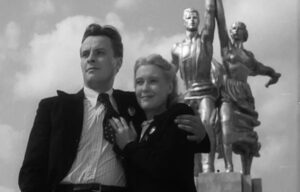
Grigory Aleksandrov’s Tanya: The Shining Path (1940) presents an even more advanced and integrated vision of Stalin’s role in the sexual and hierarchical dynamics of the Soviet family. The protagonist’s rise from a lowly domestic servant to an elite Stakhanovite laborer culminates with an embrace with her love interest, Alexei, at the foot of the statue of the Worker and Kolkhoz Woman, suggesting that the development of the New Soviet Woman must naturally result in a sexual union with the New Soviet Man (Tanya 1:32:30). However, this union requires the express permission of the state before it can be officiated or, indeed, even consummated: throughout the film, Tanya shies away from Alexei whenever they experience an intimate moment, such as during the New Year’s celebration (Tanya 44:25-44:30). Only after she receives the Order of Lenin and experiences a moment of seemingly sexual euphoria – moaning and fainting at the climax of the ceremony – does she finally become receptive to his advances (Tanya 1:17:15-1:17:30).
Stalin and the Soviet government had become so synonymous in propaganda that by the late 1930s recognition by the state meant recognition by the man. Like the official who goads Yelena into traveling East in Alone, the faceless Soviet functionary who awards Tanya the medal acts as Stalin’s proxy – the lever that he utilizes to exert his ubiquitous influence. The state approval manifested in the Order of Lenin is the Stalinist answer to the plight of Soviet women in the 1920s and ‘30s: only with the express permission of the state (i.e. a civil marriage) could sexuality be expressed.
In the post-war years, at the height of Stalinism, this trend towards Soviet film deifying Stalin as the ultimate sexual and patriarchal authority within the family reached its peak. Produced in the year 1950, Mikheil Chiaureli’s Fall of Berlin reflects the great emphasis that the state had placed on family and domesticity in response to the sexual crisis of the late 1920s. The opening few minutes of the film establish a clear distinction between feminine and masculine labor: Natasha’s place lies in teaching and child-rearing, while metalworking – one of the most stereotypically revolutionary professions in Soviet culture – belongs to Alyosha (Fall of Berlin 2:45 – 3:40). The contrast between these two images – that of the fawning female teacher surrounded by beaming children, juxtaposed against that of the hardened steelworker intent on production – defines the film’s stance on gender roles and family ideals. Moreover, the relationship between Alyosha the steelworker and Natasha the teacher demonstrates none of the “[c]ollectivism of spirit” espoused by Kollontai (170) and other earlier intellectuals as the new foundation of proletarian society.
Love and comradeship constitute two entirely separate civic obligations in the film: Natasha’s rejection of Viktor in favor of Alyosha, despite her obvious sexual attraction to Viktor, points to the importance that Soviet family policy placed on monogamy at the expense of sexual freedom (Fall of Berlin 16:35-16:55). However, even in this idealized monogamous relationship, Stalin remains the ultimate object of affection between the two parties. Natasha ultimately concludes a speech in honor of Alyosha’s achievements at the steelworks by praising Stalin with a kind of frenzied passion that surpasses even her own romantic declarations to Alyosha (Fall of Berlin 10:35-11:05).
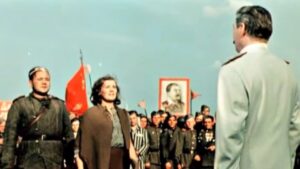
Indeed, the character of Stalin in Fall of Berlin is an almost monolithic force that commands respect and adoration. Although the most dramatic scenes are unquestionably those of Alyosha battling the Nazis at Stalingrad and in the Reichstag, the center of attention remains Stalin: the supremely productive architect, jotting down notes in his booklet while masterminding the inevitable victory of the Red Army. Similarly to the protagonist of Tanya, Natasha can only agree to love Alyosha once he has received express permission from Stalin – an icon of productivity and the implicit patriarch of their budding relationship. They both display romantic intentions in early conversations, but they only admit to these intentions after Stalin explicitly tells Alyosha to confess his love to Natasha during a meeting in Stalin’s private garden (Fall of Berlin 22:30-22:50). The biblical imagery during this sequence is striking: Stalin, dressed all in white, tends to a newly planted sapling before wiping the dirt from his hands and greeting Alyosha. In the same sense that God is the only authority capable of officiating marriage in the Christian tradition, Stalin is the only one who can officiate marriage in the Soviet tradition. This new model of the family as depicted by the film effectively inverts the triangular power dynamic practiced by the protagonists of Room’s Bed and Sofa, with the husband reduced to the same level as his wife and the state occupying the top of the structure.
Conclusion
Two different political visions of family and marriage in early Soviet film – one revolutionary and the other despotic and reactionary – represent the dramatic shift in ideology and social policy that took place within the nascent Soviet state. After the destruction wrought by the Great War and the Russian Revolution, it seemed to radical intellectuals that real and immediate social change had become not only a possibility, but a necessity. Communist writers and intellectuals carried out a concerted attack against the family as an institution, arguing that any sort of association built on exclusive relationships was inherently incompatible with the new proletarian society that was to come. This revolt against the family, exemplified by films like Abram Room’s Bed and Sofa, resulted in a sexual panic. The actual task of eliminating marriage and family proved to be much more difficult and costly than had been anticipated, and the costs only validated the fears of those opposed to it. Riding a wave of popular dissent, the newly risen Stalinist faction reversed Soviet policy and endorsed the sort of exclusive family bond that is so prominent in The Fall of Berlin.
Family and marriage became once again enshrined as respected institutions in the early Stalinist period, but they were altered to increase obedience and conformity. Stalin – with the full weight of the state represented in his mythologized figure – gradually transformed from a silent mediator to the ultimate source of authority within the new Soviet family, sanctioning and prohibiting marriages according to the demands of the collective. The increasing presence of Stalin in films from the 1930s and the post-war period, accompanied by the rehabilitation of family values, marked the definitive end of the sexual revolution championed by the radical intelligentsia of the 1920s. The conflict between these twin movements produced definite ideological currents that can be traced, as demonstrated by the examples in this paper, through contemporary Soviet film.
Works Cited
Alone. Directed by Leonid Trauberg and Grigori Kozintsev, performances by Yelena Kuzmina, Sergei Gerasimov, and Liu-Sian Van, Soyuzkino, 1931.
Bed and Sofa. Directed by Abram Room, performances by Nikolai Batalov, Lyudmila Semyonova, and Vladimir Fogel, Sovkino Studio, 1927.
Borenstein, Eliot. Men Without Women: Masculinity and Revolution in Russian Fiction, 1917-1929. Duke University Press, 2000.
Fall of Berlin. Directed by Mikheil Chiaureli, performances by Mikheil Gelovani, Boris Andreyev, and Marina Kovalyova, Mosfilm, 1949.
Goldman, Wendy Z. Women, the State and Revolution: Soviet Family Policy and Social Life, 1917-1936. Cambridge University Press, 1993.
Kollontai, Aleksandra. “Make Way for Winged Eros.” From Symbolism to Socialist Realism: Reader, edited by Irene Masing-Delic. Academic Studies Press, 2011, pg. 160-172.
Tanya. Directed by Grigory Aleksandrov, performances by Lyubov Orlova, Yevgeny Samoylov, Vladimir Volodin, and Osip Abdulov, Mosfilm, 1940.
Tractor Drivers. Directed by Ivan Pyryev, performances by Marina Ladynina, Nikolay Kryuchkov, and Boris Andreyev, Mosfilm, 1939.
You Might Also Like
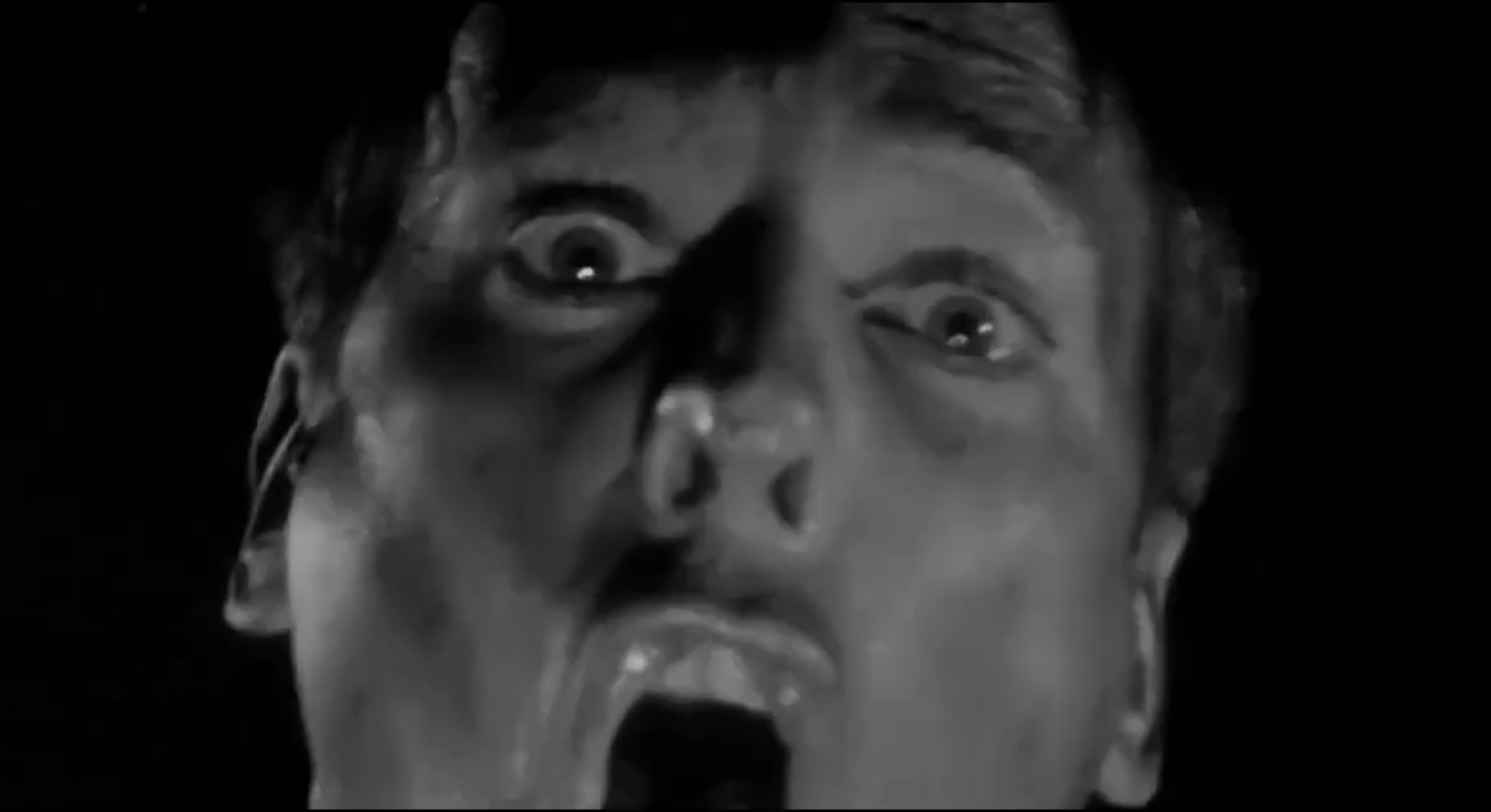
You’re Next: The Cold War in American Horror Films
During the second half of the 20th century, Cold War anxiety and paranoia played out on America’s silver screens via the explosively popular horror genre. These films both reflected and shaped how Americans understood the perceived threats of a rapidly changing world. This paper examines five horror films—Them! (1954), Invasion of the Body Snatchers (1956), […]

Russian Language Horror Films
Although Russian folklore teems with fearsome spirits and creatures, horror has never taken root as a popular genre in Russian culture. In literature, the supernatural typically inflicts psychological rather than physical torment, and modern attempts at slasher horror in film have largely failed at the Russian box office. The most successful Russian horror films instead […]
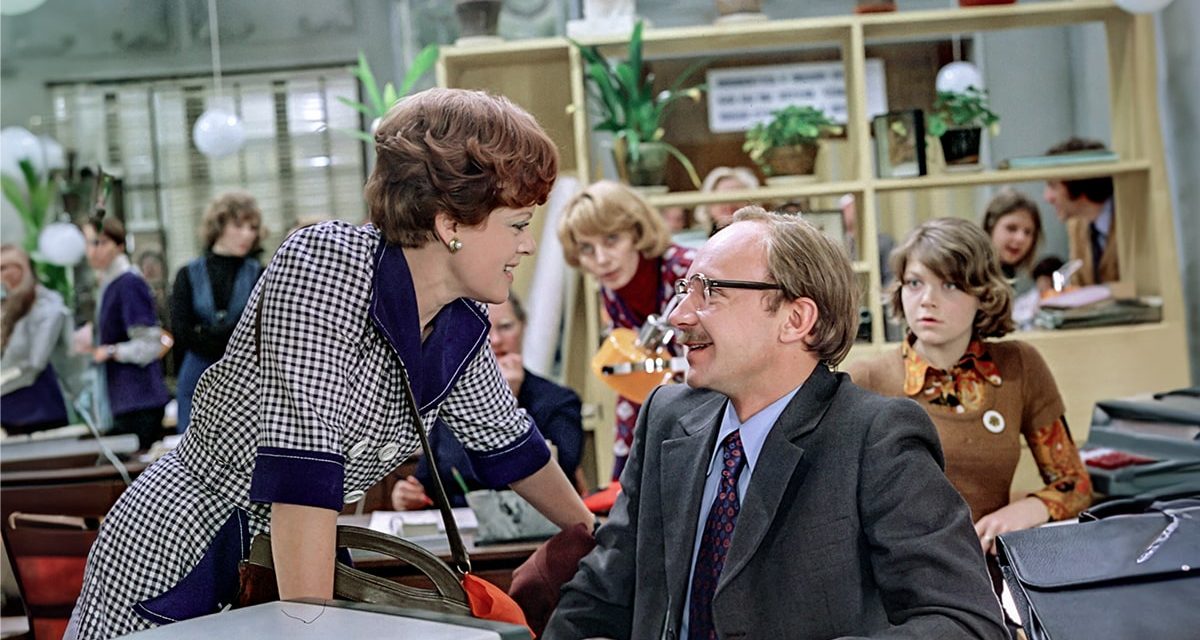
The Best Soviet Films According to Soviet Citizens
In 1925, Sergei Eisenstein’s film Battleship Potemkin was released in the Soviet Union. At the time, it was regarded as one of the most important works in the history of cinema, and still often appears on lists of the world’s greatest films. However, only in 1958 did independent film ratings in the USSR appear, when […]

7 Films About Being Estonian
The following films draw deeply from Estonian history and culture. The majority of these were both popular upon their release and are nuanced in their presentation of various eras of often difficult Estonian life. Below are seven modern films that are well known to Estonians and often cited as exemplary of their film industry. All […]

7 Films About Being Latvian
Many of Latvia’s most successful modern films explore expressly Latvian themes, placing the unique cultural, historical, and social experiences of the Latvian people on screen. These films often explore topics such as Latvia’s difficult past of war and occupation, telling the stories of Latvia’s national heroes, or exploring the complexities of Latvia’s national identity. Below […]


